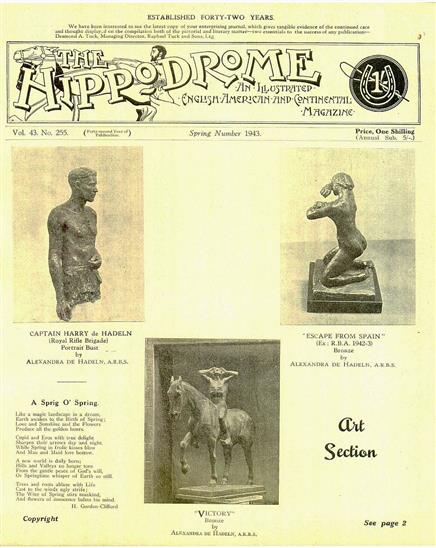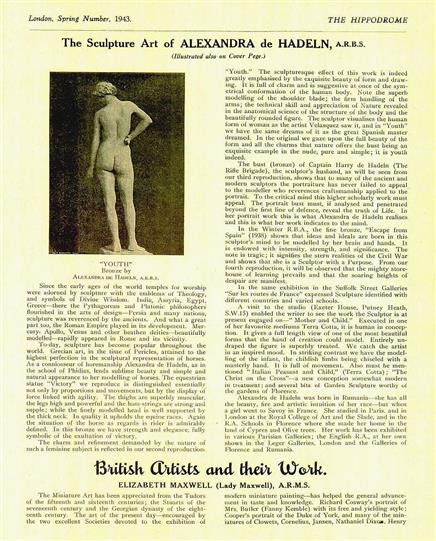



L'article publié en pleine guerre (printemps 1943) par « L'hippodrome » à l'occasion de la préparation d'une exposition itinérante d'artistes anglais, semble-t-il sur le thème « Sur les routes de France », est l'un des rares articles à être consacré exclusivement aux sculptures de Alexandra de Hadeln. L'auteur s'est rendu à l'atelier à Exeter House, Putney Heath à Londres pour rencontrer l'artiste au travail. Parmi d'autres, il écrit également au sujet de deux sculptures aujourd'hui disparues : l'homme à cheval intitulé ici « La Victoire » ( mais ailleurs « The Herald ») et d'un crucifix. Selon toute vraisemblance il n'aurait vu que des photographies de ces deux œuvres créées sauf erreur à Florence et abandonnées lors du départ pour Londres. Intriguant est toutefois le fait qu'il parle pour « La Victoire » d'un « bronze » alors que la photo publiée montre le modèle en argile.
Après avoir analysé la justesse des traits du cheval de la « Victoire » « En tant que connaisseur de l'équitation, Alexandra de Hadeln, comme à l'école de Phidias, prête une beauté sublime avec simplicité et naturel en modelant le cheval » écrit l'auteur « ...nous trouvons ici la force et l'élégance, totalement symbolique de l'exultation de la Victoire ».
The Hippodrome
Londres, Numero du Printemps, 1943
L'art de la Sculpture de Alexandra de Hadeln
Au sujet de la sculpture « Jeunesse » il écrit : « Le sculpteur visualise la forme humaine de la femme comme l'artiste Velasquez la voyait, et avec « La Jeunesse » nous retrouvons le même rêve que le grand artiste espagnol avait ». Aussi sujet du « buste en bronze du Capitaine Harry de Hadeln (The Rifle Brigade), le mari du sculpteur... » « si l'on pénètre au-delà de la première ligne de défense, la vérité de la vie se révèle ». Sur « Échappé d'Espagne » (1938) l'auteur écrit : « Le ton est tragique ; il indique la crue réalité de la Guerre Civile et montre qu'elle est un sculpteur qui veut transmettre un message. ». Enfin il s'attarde sur la sculpture de « La Mère et l'Enfant » en Terra Cotta qu'apparemment Alexandra de Hadeln terminait pour écrire « Quelle donne une pleine vue d'une des plus belles formes que les mains d'un créateur puisse modeler ». Enfin avec le « Christ en Croix » il mentionne également une Terra Cotta « Paysan italien avec l'Enfant » dont il n'existe aujourd'hui aucune trace connue. Pour conclure, après avoir rappelé qu'elle est née en Roumanie, il écrit sur Alexandra de Hadeln, qu'elle « a toute la beauté, le feu et l'intuition artistique de sa race... ».

Since the early ages of the world temples for worship were adorned by sculpture with the emblems of Theology, and symbols of Divine Wisdom. India, Assyria, Egypt, Greece - there the Pythagorean and Platonic philosophers flourished in the arts of design - Persia and many nations, sculpture was reverenced by the ancients. And what a great part too, the Roman Empire played in its development. Mercury, Apollo, Venus and other heathen deities - beautifully modelled - rapidly appeared in Rome and its vicinity.
To-day, sculpture lias become popular throughout the world. Grecian art, in the time of Perides, attained to the highest perfection in the sculptural representation of horses. As a connoisseur of horsemanship Alexandra de Hadeln, as in the school of Phidias, lends sublime beauty and simple and natural appearance to her modelling of horses. The equestrian statue "Victory" we reproduce is distinguished essentially not only by proportions and movements, but by the display of force linked with agility. The thighs are superbly muscular, the legs high and powerful and the ham-strings are strong and supple; white the finely modelled head is well supported by the thick neck. ln quality it upholds the equine races. Again the situation of the horse as regards is rider is admirably defined. In this bronze we have strength and elegance, fully symbolic of the exultation of victory.
The charm and refinement demanded bv the nature of such a feminine subject is reflected in our second reproduction, "Youth." The sculpturesque effect of this work is indeed greatly emphasised by the exquisite beauty of form and drawing. It is full of charm and is suggestive at once of the symmetrical conformation of the human body. Note the superb modelling of the shoulder blade; the firm handling of the arms; the technical skill and appreciation of Nature revealed in the anatomical science of the structure of the body and the beautifully rounded figure. The sculptor visualises the human form of woman as the artist Velasquez saw it, and in "Youth" we have the same dreams of it as the great Spanish master dreamed. ln the original we gaze upon the full beauty of the form and all the charms that nature offers the bust being an exquisite example in the nude, pure and simple; it is youth indeed.
The bust (bronze) of Captain Harry de Hadeln (The Rifle Brigade), the sculptor's husband, as will be seen from our third reproduction, shows that to many of the ancient and modern sculptors the portraiture has never failed to appeal to the modeller who reverences craftsmanship applied to the portrait.



The Hippodrome
London, Spring Number, 1943
The Sculpture Art of ALEXANDRA de HADELN, A.R.B.S.
To the critical mind this higher scholarly work must appeal. The portrait bust must, if analysed and penetrated beyond the first line of defence, reveal the truth of Life. ln her portrait work this is what Alexandra de Hadeln realises and this is what her work indicates to the mind.
ln the Winter R.B.A., the fine bronze, "Escape from Spain" (1938) shows that ideas and ideals are born in this sculptor's mind to be modelled by her brain and hands. It is endowed with intensity, strength, and significance. The note is tragic; it signifies the stern realities of the Civil War and shows that she is a Sculptor with a Purpose. From our fourth reproduction, it will be observed that the mighty storehouse of learning prevails and that the soaring heights of despair are manifest.
ln the same exhibition in the Suffolk Street Galleries "Sur les routes de France" expressed Sculpture identified with different countries and varied schools.
A visit to the studio (Exeter House, Putney Heath, S.W.I5) enabled the writer to see the work the Sculptor is at present engaged on - "Mother and Child." Executed in one of her favourite mediums Terra Cotta, it is human in conception. It gives a full-length view of one of the most beautiful forms that the hand of creation could model. Entirely undraped the figure is superbly treated. We catch the artist in an inspired mood. ln striking contrast we have the modelling of the infant, the childish limbs being chiselled with a masterly hand. It is full of movement. Also must be mentioned "Italian Peasant and Child," (Terra Cotta); "The Christ on the Cross" - a new conception somewhat modern in treatment; and several bits of Garden Sculpture worthy of the gardens of Florence.
Alexandra de Hadeln was born in Romania - she has all the beauty, fire and artistic intuition of her race - but when a girl went to Savoy in France. She studied in Paris. and in London at the Royal College of Art and the Slade, and in the R.A. Schools in Florence where she made her home in the land of Cypress and Olive trees. Her work has been exhibited in various Parisian Galleries; the English R.A., at her own shows in the Leger Galleries, London and the Galleries of Florence and Romania.
Page 1 of 2





